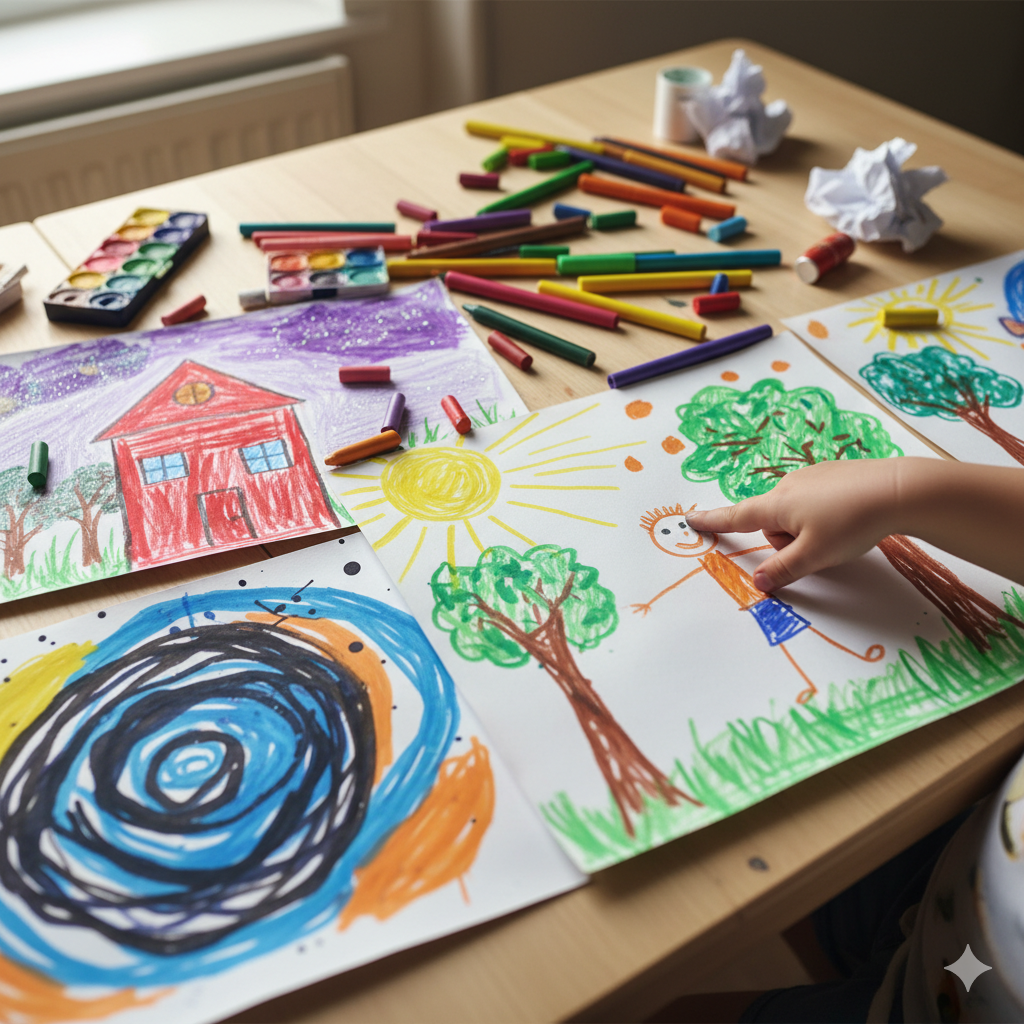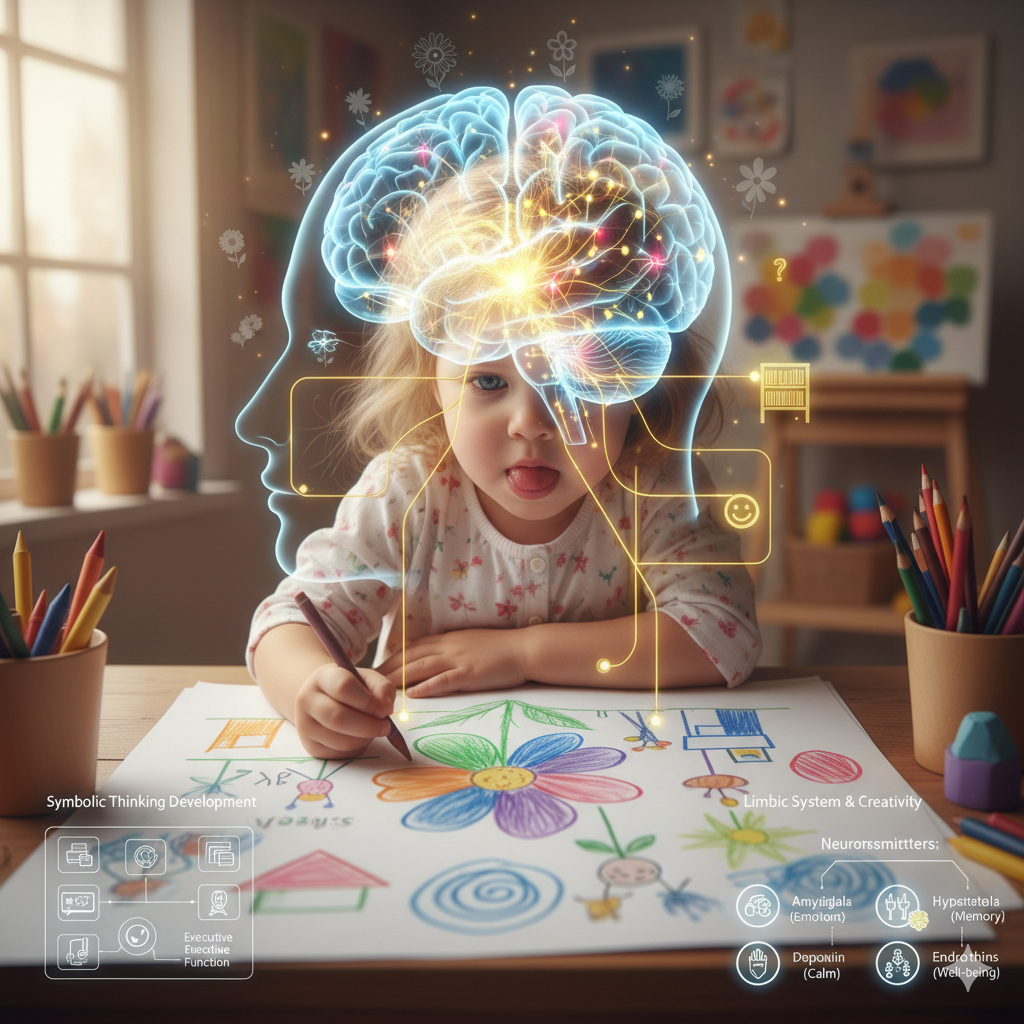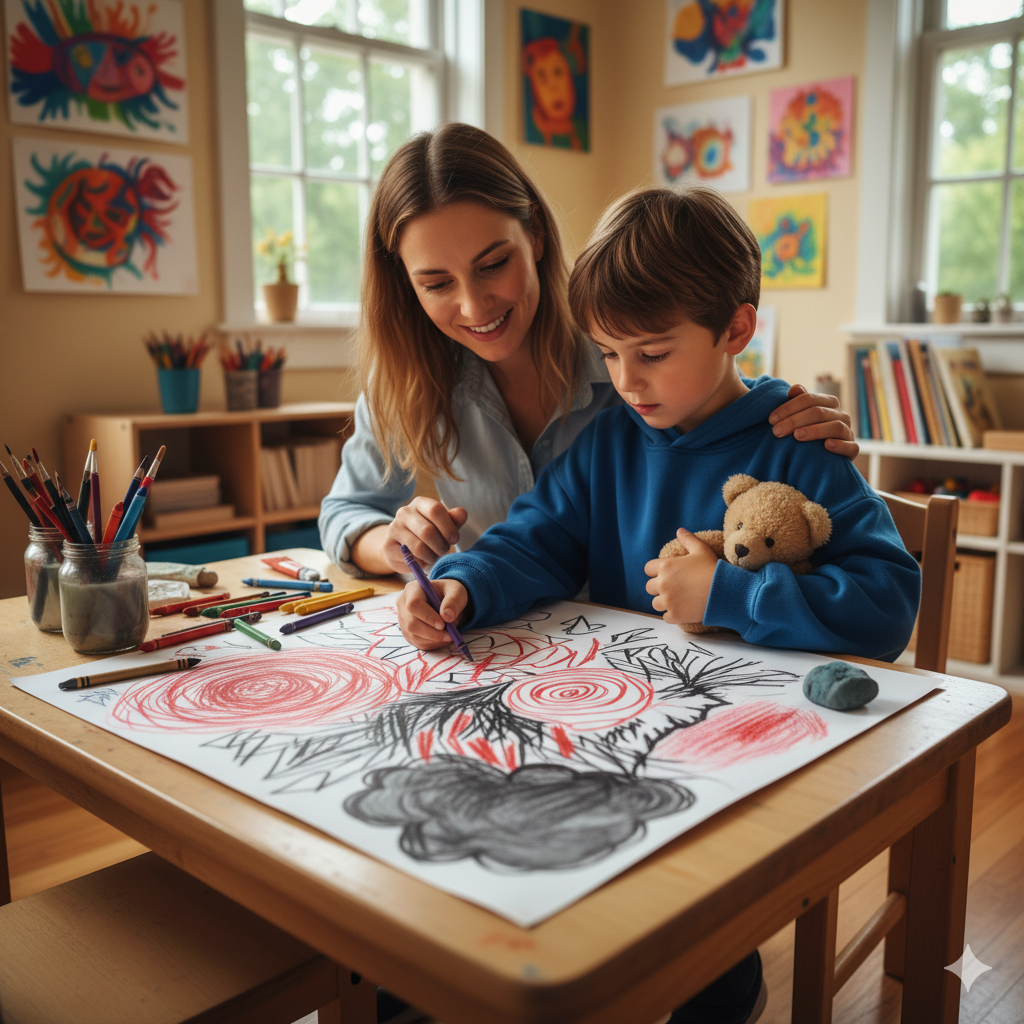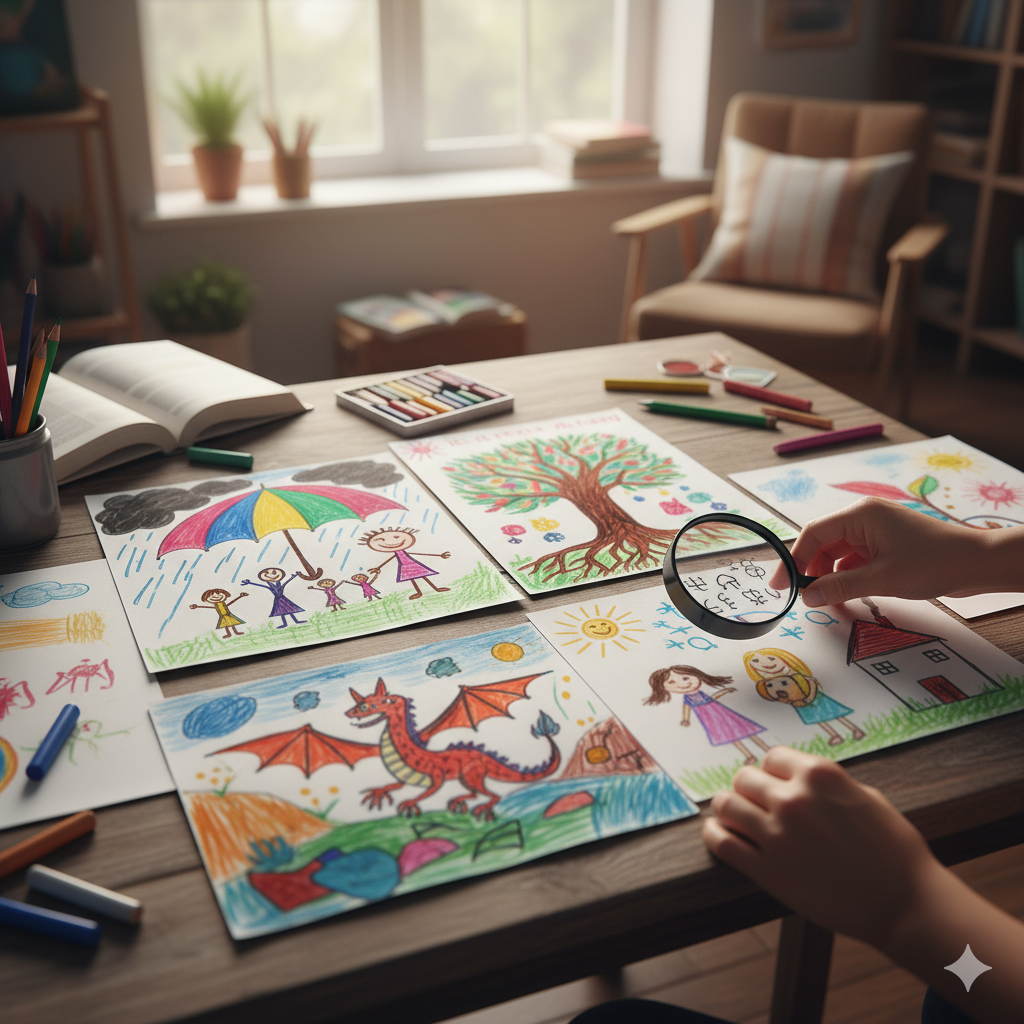Color Psychology in Children's Drawings: What Do Colors Mean?
Last week, my five-year-old daughter spent an entire afternoon drawing the same picture over and over—a house with a bright red roof and a purple sky. When I asked her why she kept choosing those same colors, she looked at me with the kind of certainty only a child can have and said, "Because red is brave and purple is magic, Mommy." That moment opened my eyes to the incredible world of color psychology in children's artwork.
Have you ever noticed that your child gravitates toward certain colors in their drawings? Whether they're painting a bright red fire truck or coloring the sky in purple, children's color choices aren't random. These choices can provide fascinating insights into their emotional world, personality traits, and developmental stage.
---
The Amazing Science Behind Children and Color
How Their Brains Process Color
What's happening when your child picks up a red crayon instead of a blue one is actually quite remarkable. Their developing brain is processing color through multiple pathways: visual processing centers are interpreting the wavelengths of light, emotional centers are creating associations with feelings, and cultural influences are shaping their preferences.
But here's what makes it even more fascinating: every child's color perception is unique. My daughter's red might feel completely different to her than it does to her best friend. Personal experiences, family preferences, and even the lighting in their room can all influence how they relate to different colors.
The Journey of Color Understanding
I've watched my children's relationship with color evolve in real-time. When my daughter was two, she would name colors correctly but use them randomly—her sun might be green and her grass blue, and she was perfectly content with that. By age three, she started developing preferences, often influenced by what she saw in movies or what her friends liked.
Now, at five, she uses color symbolically and emotionally. She chooses red when she's feeling confident and bold, blue when she wants to create something peaceful, and purple when she's feeling particularly imaginative. It's like watching her emotional vocabulary expand through color.
---
Common Color Meanings in Children's Art
While individual interpretation is important, research has identified some common patterns in how children use colors.
Red: Energy, Passion, and Intensity
Red often signifies high energy levels, which could mean the child is active or excitable. It is strongly linked to intense emotions, such as anger or excitement, and may indicate a desire for assertiveness or a need to draw attention to an important element. It’s worth noting that in younger children, red might simply be a favorite color without a deeper emotional meaning.
Blue: Calm, Trust, and Stability
Blue typically represents calm emotions, suggesting peaceful and relaxed feelings. It can symbolize a need for security and feeling safe or can represent trust in dependable relationships. However, in some contexts, blue can also indicate melancholy or sadness.
Yellow: Joy, Optimism, and Creativity
Yellow often symbolizes happiness and an optimistic outlook. It is strongly associated with creativity, original thinking, and imagination. Furthermore, it can represent mental energy and alertness or a desire for attention-seeking, drawing focus to specific elements.
Green: Growth, Nature, and Balance
Green typically indicates a desire for harmony, suggesting the child feels balanced and centered. It is a color of growth, whether that is personal development or learning, and often shows an appreciation for nature and the environment. It can also be associated with healing or recovery from stress or illness.
Purple: Imagination, Spirituality, and Sensitivity
Purple often represents creativity, indicating a rich imagination and artistic sensitivity. It can symbolize a connection to spirituality or something beyond the physical, and it is frequently linked to empathy and high emotional sensitivity. Ultimately, purple can also express a child's individuality and desire to stand out from the crowd.
Orange: Enthusiasm, Social Connection, and Warmth
Orange typically symbolizes social energy and enthusiasm for interacting with others, radiating a warmth that suggests a friendly, approachable personality. It is a color of excitement and eager anticipation, representing a balance by combining the energy of red with the happiness of yellow.
Black: Power, Mystery, and Protection
Black often represents a feeling of authority, suggesting the child feels powerful or in control. It can be used for protection, creating boundaries or barriers, or to express an interest in the mystery or unknown. In certain contexts, black can also signify grief or the processing of loss.
White: Purity, Simplicity, and Peace
White typically indicates innocence and pure, uncomplicated feelings. It is often associated with clarity in thinking or decision-making and a desire for peace or a serene emotional state. Furthermore, white can symbolize new beginnings or a clean slate.
---
Factors That Influence Color Choice
A child's color selection is never determined by a single factor, but by a complex interplay of influences.
Cultural and Social Influences
Color choice is often shaped by the world around the child. This includes gender stereotypes (though changing, like pink for girls and blue for boys), broader cultural associations where different cultures assign different meanings to colors, and the influence of media through characters and shows. Even family preferences and the colors used in the home environment can play a role.
Emotional State
Colors are frequently a direct window into a child's feelings. They often reflect the child's current mood and their stress levels—for instance, anxious children might prefer darker colors. A child's energy levels are also a factor, with high-energy children often preferring bright, bold colors. Finally, their comfort level can be seen, as secure children might use warm, calming colors.
Developmental Stage
A child's age is a major determinant. Younger children might use colors randomly, while older children use them more intentionally as their symbolic thinking develops. Their artistic development brings more sophisticated color choices with age, and their cognitive abilities grow to include an understanding of color mixing and relationships.
Personal Preferences
Every child's internal world affects their choices. This includes their individual personality and natural preference for certain colors. Sensory sensitivity may cause children to avoid certain colors. Learning style matters too, as visual learners might be more color-conscious. Finally, personal experiences often create unique color associations.
---
How to Interpret Color Use in Your Child's Art
When analyzing your child’s drawings, it’s best to adopt a holistic approach by looking for patterns, considering the context, and asking thoughtful questions.
Look for Patterns
It's important to look for consistent choices—does your child always use certain colors? Observe the color combinations and how colors work together in the artwork. Pay attention to color intensity; are the colors used boldly or lightly? Finally, note the color placement and where on the page different colors are used.
Consider Context
Interpretation requires considering the circumstances around the drawing. What is your child drawing, and what is the subject matter? Has anything significant happened recently? The time of day or the social setting (whether the child was alone or with others) when the artwork was created can also offer clues.
Ask Questions
The most valuable insights often come directly from the artist. You can open the conversation with questions like:
* "Tell me about your colors," to allow your child to explain their choices.
* "What made you choose that color?" to understand their reasoning.
* "How does that color make you feel?" to explore emotional connections.
* "What do you think about when you see that color?" to discover associations.
---
Red Flags: When to Pay Attention
While most color use is a normal and healthy form of expression, certain persistent patterns might indicate a need for attention.
Concerning Patterns
Look out for the exclusive use of black or dark colors, which might indicate depression or trauma. Complete avoidance of color could suggest sensory issues or emotional withdrawal. Extreme color intensity might be a sign of high stress or overstimulation. Also, be aware of inappropriate color use, such as colors that consistently do not match the subject matter.
When to Seek Help
It is the persistence of a pattern that matters, not an isolated incident. Seek professional help if you observe:
* Persistent dark themes where the art is consistently disturbing or dark.
* Regression in color use, such as a child who previously used bright colors now only using dark ones.
* Color-related anxiety, where a child becomes visibly upset about color choices.
* Sensory issues that manifest as extreme reactions to certain colors.
Remember: Occasional use of dark colors is normal. It's persistent patterns that matter.
---
Supporting Healthy Color Expression
To foster healthy expression, parents and educators should provide materials and encourage exploration.
Provide a Variety of Colors
Ensure children have access to a full spectrum of colors and different mediums, such as crayons, markers, paints, and colored pencils. Teach them about color mixing to create new shades and include natural colors and earth tones in the palette.
Encourage Color Exploration
Children should have no restrictions and be allowed to choose any colors they want. Encourage creativity through color games or by having them create color stories using different colors. Talk about color emotions to help them connect colors to how they feel.
Model Healthy Color Use
Share your personal color preferences and talk about your favorite colors. Show variety by using different colors in your own artwork and avoid stereotypes that limit children based on gender or age. Most importantly, celebrate all choices and appreciate all color combinations.
---
Using Color to Support Development
Color is a powerful tool that can aid in various aspects of a child's development.
For Emotional Regulation, you can use calm colors like blues and greens for relaxation or energy colors like reds and oranges for motivation. Encourage balance by mixing different color types and allow colors to serve as a means of expression for children's feelings.
In Learning and Memory, colors can be used for color coding to organize information. Visual memory is enhanced as colors help children remember concepts, and bright colors can aid in focusing attention. Overall, color exploration enhances creative thinking.
For Social Development, using colors helps children practice sharing and taking turns. They learn about color preferences, understanding that others have different tastes, which aids collaboration on colorful projects. Finally, colors serve as a key tool for communication to express ideas to others.
---
Conclusion
Color psychology in children's drawings is a fascinating field that can help parents understand their child's emotional world. While color meanings can provide valuable insights, it's important to remember that every child is unique. The same color might mean different things to different children, and context is always important.
The most important thing is to create an environment where children feel free to explore and express themselves through color. By providing a variety of materials and encouraging color exploration, you're supporting not just their artistic development, but their emotional and cognitive growth as well.
Pay attention to your child's color choices, but don't overanalyze. Sometimes a red fire truck is just a red fire truck, and sometimes it's a symbol of power and excitement. The beauty of children's art is that it can be both literal and symbolic at the same time.
Want to explore what your child's specific color choices might reveal? Our AI-powered analysis tool can provide detailed insights into the color psychology and artistic expression in your child's drawings. Try our child drawing analysis tool to discover the hidden meanings in your child's artwork.
---
Remember: Color psychology is a general guide. Individual children may have unique associations with colors based on their personal experiences and personality.



